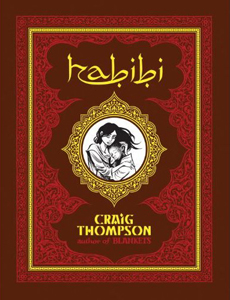Habibi (graphic novel)
| Habibi | |
|---|---|
 |
|
| Publication information | |
| Publisher | Pantheon Books |
| Genre |
Romance Drama |
| Publication date | September 20, 2011 |
| Creative team | |
| Writer(s) | Craig Thompson |
| Artist(s) | Craig Thompson |
| Collected editions | |
| Paperback | |
Habibi is a graphic novel by Craig Thompson published by Pantheon in September 2011. The 672-page book is set in a fictional Islamic fairy tale landscape, and depicts the relationship between Dodola and Zam, two escaped child slaves, who are torn apart and undergo many transformations as they grow into new names and new bodies, which prove to be obstacles to their love when they later reunite. The book's website describes its concept thus as a love story and a parable about humanity's relationship to the natural world that explores such themes as the cultural divide between the first and third worlds, the common heritage of Christianity and Islam.
While it has been lauded by publications such as Time, Elle, Salon, NPR and reviewers in general for the beauty of its visual design and the rendition of its epic setting, it has also been criticized for its treatment of sexuality, and its depiction of Arabs and Arab culture.
Thompson began working on Habibi at the end of 2004. Although the book is informed by his previous work, Blankets, which autobiographically explored Thompson's Christian upbringing and beliefs, Thompson conceived Habibi as part of his desire to better understand and humanize Islam, and focus on the beauty of Arabic and Islamic cultures, in contrast to their vilification.
In the course of producing the story, Thompson was inspired by Arabic calligraphy, interpreting that form of writing as cursive shorthand for an idea, which Thompson says, is the origin of cartooning. Each of the book's nine chapters is given a distinctive visual style, and an Arab North African talisman is employed as a framing device. The book also quotes explicitly from 19th-century Orientalist paintings, particularly those of Jean-Léon Gérôme.
Habibi takes place in the present day, albeit in a fictional "Orientalist landscape", which Thompson conceived in order to create a sprawling fairy tale that would allow him to depict a clash of the old world and the new, while allowing him to avoid depicting guns or warfare. While it is located in an Islamic country and features such elements as Arabic writing, Thompson is reluctant to say that it takes place in the Middle East, preferring to emphasize that it is a mythical landscape, and that the characters are vaguely Muslim as a result of the context in which they grew up. Thompson explains that he borrowed elements from different geographies, and infused them with the elements that he wanted. The book intersperses stories drawn from the Koran with the main narrative that follows Dodola, a young girl who, despite being intelligent and literate, is prized for her beauty, and the younger Zam, a boy whose guilt-ridden relationship with his surrogate mother leads to destructive choices.
...
Wikipedia
